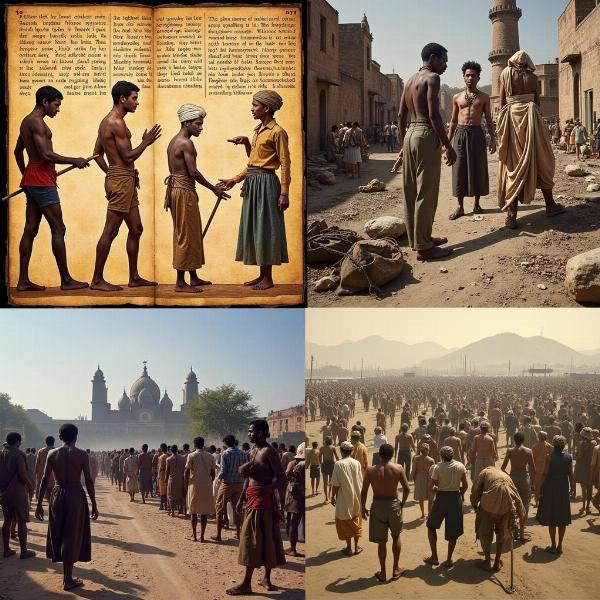Understanding the meaning of “enslaved” in Hindi is crucial for accurately translating and interpreting texts related to history, social justice, and human rights. The word “enslaved” signifies a state of forced servitude, where an individual is deprived of their freedom and treated as property. This concept resonates deeply within Indian culture and history, with its own nuances and terminology.
Delving into the Hindi Translations of “Enslaved”
Several Hindi words capture the essence of “enslaved,” each with its own connotations and historical context. Some of the most common translations include:
- गुलाम (gulam): This is perhaps the most direct translation and commonly used word for “slave” or “enslaved.” It derives from the Arabic word “ghulam,” reflecting the historical influence of Islamic rule in India. Gulam emphasizes the aspect of ownership and control over another person.
- दास (daas): This term also means “slave” or “servant,” but it can also imply a devotee or follower. Historically, the word “daas” was used in various contexts, from describing household servants to referring to individuals dedicated to a religious figure. This adds a layer of complexity to its meaning, as it can signify both forced servitude and voluntary devotion.
- बंधुआ मजदूर (bandhua mazdoor): This phrase translates to “bonded laborer,” referring to individuals forced to work to repay a debt. This form of modern slavery still persists in some parts of India and highlights the economic exploitation aspect of enslavement.
- कृषिदास (krishidaas): Specifically referring to an agricultural slave or serf, this term reflects the historical prevalence of agrarian societies in India and the exploitation of labor within those systems.
Historical Context of Slavery in India
India, like many other parts of the world, has a long and complex history of slavery. From ancient times to the colonial era, various forms of enslavement existed across the subcontinent. Understanding this history is essential for grasping the full meaning of “enslaved” within the Indian context.
Ancient and Medieval Slavery
Ancient texts and historical accounts reveal the presence of slavery in ancient India, although its prevalence and nature varied across different regions and periods. The caste system also played a role, with certain groups being more vulnerable to enslavement.
Colonial Influence on Slavery
The arrival of European colonial powers further complicated the landscape of slavery in India. The transatlantic slave trade and the indentured labor system introduced new forms of exploitation and human trafficking.
 Historical Context of Slavery in India
Historical Context of Slavery in India
The Social and Cultural Impact of Slavery
The legacy of slavery continues to impact Indian society and culture. Understanding the lasting effects of this historical injustice is crucial for addressing present-day issues of social inequality and discrimination.
Caste and Social Hierarchy
The caste system, while not directly synonymous with slavery, has historically created hierarchies and vulnerabilities that contributed to the practice of enslavement.
The Fight for Abolition
India’s struggle for independence from colonial rule was intertwined with the fight against slavery and other forms of oppression. Social reformers and activists played a vital role in raising awareness and advocating for the abolition of slavery.
“Enslaved” in Modern Context: Human Trafficking and Bonded Labor
While legally abolished, the specter of enslavement persists in modern India in the form of human trafficking and bonded labor. These contemporary forms of exploitation highlight the ongoing need for vigilance and social action.
Conclusion
Understanding the meaning of “enslaved” in Hindi requires more than just a simple translation. It involves delving into the historical, social, and cultural context of slavery in India. From the various Hindi words used to describe enslavement to the ongoing struggle against modern-day forms of exploitation, this exploration sheds light on a complex and multifaceted issue. Recognizing the nuances of this term empowers us to engage in more informed discussions about human rights, social justice, and the ongoing fight for freedom and equality.
FAQ
- What is the most common Hindi word for “enslaved”? The most common Hindi word for “enslaved” is गुलाम (gulam).
- What is the difference between “gulam” and “daas”? While both mean “slave,” “daas” can also imply devotion or servitude to a religious figure.
- What is bandhua mazdoor? Bandhua mazdoor refers to bonded laborers, individuals forced to work to repay a debt.
- Does slavery still exist in India? While legally abolished, modern forms of slavery like human trafficking and bonded labor persist in India.
- What is krishidaas? Krishidaas refers to an agricultural slave or serf.
Meaning-Hindi.in offers professional translation services specializing in Hindi and other languages. Our expertise in legal, business, technical, and educational translation ensures accuracy and cultural sensitivity. Whether you need document translation, website localization, or interpretation services, Meaning-Hindi.in can provide high-quality solutions tailored to your specific needs. Contact us at [email protected] or +91 11-4502-7584 to discuss your translation requirements.